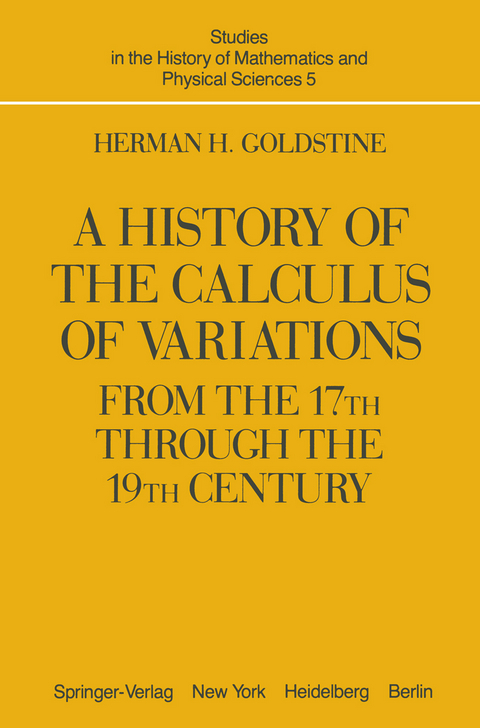
A History of the Calculus of Variations from the 17th through the 19th Century
Springer-Verlag New York Inc.
978-1-4613-8108-2 (ISBN)
The calculus of variations is a subject whose beginning can be precisely dated. It might be said to begin at the moment that Euler coined the name calculus of variations but this is, of course, not the true moment of inception of the subject. It would not have been unreasonable if I had gone back to the set of isoperimetric problems considered by Greek mathemati cians such as Zenodorus (c. 200 B. C. ) and preserved by Pappus (c. 300 A. D. ). I have not done this since these problems were solved by geometric means. Instead I have arbitrarily chosen to begin with Fermat's elegant principle of least time. He used this principle in 1662 to show how a light ray was refracted at the interface between two optical media of different densities. This analysis of Fermat seems to me especially appropriate as a starting point: He used the methods of the calculus to minimize the time of passage cif a light ray through the two media, and his method was adapted by John Bernoulli to solve the brachystochrone problem. There have been several other histories of the subject, but they are now hopelessly archaic. One by Robert Woodhouse appeared in 1810 and another by Isaac Todhunter in 1861.
1. Fermat, Newton, Leibniz, and the Bernoullis.- 1.1. Fermat’s Principle of Least Time.- 1.2. Newton’s Problem of Motion in a Resisting Medium.- 1.3. The Brachystochrone Problem.- 1.4. The Problem Itself.- 1.5. Newton’s Solution of the Brachystochrone Problem.- 1.6. Leibniz’s Solution of the Brachystochrone Problem.- 1.7. John Bernoulli’s First Published Solution and Some Related Work.- 1.8. James Bernoulli’s Solution.- 1.9. James Bernoulli’s Challenge to His Brother.- 1.10. James Bernoulli’s Method.- 1.11. John Bernoulli’s 1718 Paper.- 2. Euler.- 2.1. Introduction.- 2.2. The Simplest Problems.- 2.3. More General Problems.- 2.4. Invariance Questions.- 2.5. Isoperimetric Problems.- 2.6. Isoperimetric Problems, Continuation.- 2.7. The Principle of Least Action.- 2.8. Maupertuis on Least Action.- 3. Lagrange and Legendre.- 3.1. Lagrange’s First Letter to Euler.- 3.2. Lagrange’s First Paper.- 3.3. Lagrange’s Second Paper.- 3.4. Legendre’s Analysis of the Second Variation.- 3.5. Excursus.-3.6. The Euler-Lagrange Multiplier Rule.- 4. Jacobi and His School.- 4.1. Excursus.- 4.2. Jacobi’s Paper of 1836.- 4.3. Excursus on Planetary Motion.- 4.4. V.-A. Lebesgue’s Proof.- 4.5. Hamilton-Jacobi Theory.- 4.6. Hesse’s Commentary.- 5. Weierstrass.- 5.1. Weierstrass’s Lectures.- 5.2. The Formulation of the Parametric Problem.- 5.3. The Second Variation.- 5.4. Conjugate Points.- 5.5. Necessary Conditions and Sufficient Conditions.- 5.6. Geometrical Considerations of Conjugate Points.- 5.7. The Weierstrass Condition.- 5.8. Sufficiency Arguments.- 5.9. The Isoperimetric Problem.- 5.10. Sufficient Conditions.- 5.11. Scheeffer’s Results.- 5.12. Schwarz’s Proof of the Jacobi Condition.- 5.13. Osgood’s Summary.- 6. Clebsch, Mayer, and Others.- 6.1. Introduction.- 6.2. Clebsch’s Treatment of the Second Variation.- 6.3. Clebsch, Continuation.- 6.4. Mayer’s Contributions.- 6.5. Lagrange’s Multiplier Rule.- 6.6. Excursus on the Fundamental Lemma and on Isoperimetric Problems.- 6.7. The Problem of Mayer.- 7. Hilbert, Kneser, and Others.- 7.1. Hilbert’s Invariant Integral.- 7.2. Existence of a Field.- 7.3. Hibert, Continuation.- 7.4. Mayer Families of Extremals.- 7.5. Kneser’s Methods.- 7.6. Kneser on Focal Points and Transversality.- 7.7. Bliss’s Work on Problems in Three Space.- 7.8. Boundary-Value Methods.- 7.9. Hilbert’s Existence Theorem.- 7.10. Bolza and the Problem of Bolza.- 7.11. Carathéodory’s Method.- 7.12. Hahn on Abnormality.
| Reihe/Serie | Studies in the History of Mathematics and Physical Sciences ; 5 |
|---|---|
| Zusatzinfo | 410 p. |
| Verlagsort | New York, NY |
| Sprache | englisch |
| Maße | 155 x 235 mm |
| Themenwelt | Sachbuch/Ratgeber ► Natur / Technik ► Garten |
| Mathematik / Informatik ► Mathematik ► Allgemeines / Lexika | |
| Mathematik / Informatik ► Mathematik ► Analysis | |
| Mathematik / Informatik ► Mathematik ► Geschichte der Mathematik | |
| Naturwissenschaften | |
| Schlagworte | Analysis • Calculus • History • Variations • Variationsrechnung |
| ISBN-10 | 1-4613-8108-8 / 1461381088 |
| ISBN-13 | 978-1-4613-8108-2 / 9781461381082 |
| Zustand | Neuware |
| Haben Sie eine Frage zum Produkt? |
aus dem Bereich


